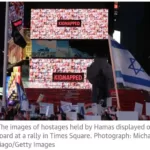In a troubling development, Western officials have raised concerns over the potential “spillover” effect of the ongoing Israel-Hamas conflict. The situation has taken a dangerous turn as US forces in the region have encountered increasing threats, and American bases in Iraq and Syria have been repeatedly targeted by drone attacks.
Ain al-Asad Airbase, which houses both US and international forces in western Iraq, came under attack from drones and missiles, causing multiple blasts within the base. Security sources, speaking to Reuters, reported this alarming incident. The Iraqi military swiftly responded, sealing off the area around the base and launching a search operation. The extent of casualties and damages remains uncertain.
This attack follows rocket strikes on another military base hosting US forces near Baghdad’s international airport, as reported by Iraqi police. Additionally, US military forces in Iraq experienced two separate drone attacks on Wednesday, one resulting in minor injuries to a small number of troops, despite successful interception by the US military.
In Syria, a drone struck US forces, causing minor injuries, while another drone was successfully taken down.
Meanwhile, the USS Carney, a US Navy destroyer in the northern Red Sea, intercepted three land attack cruise missiles and several drones launched by Houthi forces in Yemen. While the destination of the missiles is yet to be definitively determined, a Pentagon spokesperson mentioned that they were “potentially” headed towards Israel. This action may represent the first instance of the US military intervening in defense of Israel during this conflict.
As tensions escalate in the region, President Joe Biden has deployed significant naval assets, including two aircraft carriers, other warships, and around 2,000 Marines. This move aims to enhance the US military’s readiness in the face of increased activities by Iran-backed groups, given the rising regional tensions amidst the Israel-Hamas war.
Israel, in response to the October 7th assault by Hamas, has called up a record 360,000 reservists and has intensified its bombardment of the Gaza Strip. The situation in Gaza has resulted in a significant loss of life, with approximately 3,785 Palestinians killed and 12,493 wounded in Israeli strikes, according to the Hamas-run health ministry in Gaza.
Despite these developments, the Pentagon has not identified a direct link between the heightened attacks on US and Israeli forces in the Middle East and the Israel-Hamas conflict.
Last week, armed groups in Iraq with affiliations to Iran issued threats to target US interests using missiles and drones if the US supported Israel against Hamas in Gaza.
European Commission president Ursula von der Leyen emphasized the real threat of regional spillover from the Israel-Hamas conflict and called for continued dialogue between Israel and its neighboring nations. She also pointed to Iran as a patron of Hamas and its potential to escalate the chaos.
The situation is precarious, with the US maintaining 2,500 troops in Iraq and an additional 900 in neighboring Syria. These troops are on a mission to advise and assist local forces in combating the Islamic State. Iraq was already experiencing heightened tension due to the conflict in Gaza, with leading Shia cleric Grand Ayatollah Ali al-Sistani condemning Israel’s actions and calling for international intervention.
Kataib Hezbollah, a powerful armed faction with close ties to Iran, accused the US of supporting Israel and called for the US to leave Iraq. Notably, there had been a relative calm in attacks on US forces in Iraq due to a truce in place since the previous year.
The situation in the Middle East is becoming increasingly volatile, and it is imperative to closely monitor these developments as they unfold.






